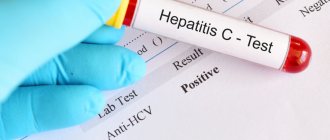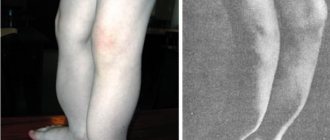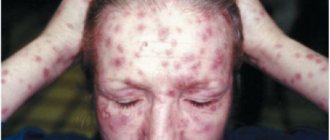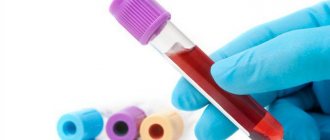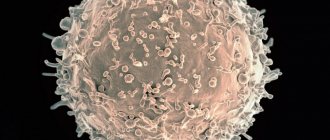Complexes with this research
Expanded hospital complex Expanded infectious screening for prevention and hospitalization 7,890 ₽ Composition
Women's check-up No. 1 38 studies for annual preventive examination 19,720 ₽ Composition
Examination during pregnancy. 1st trimester 17,040 ₽ Composition
IN OTHER COMPLEXES
- Preparation for IVF for a man RUB 6,210
- Future dad 8,650 RUR
- Eight infections. Complex for women 5,370 ₽
- Men's check-up No. 1 RUB 18,920
- Eight infections. Complex for men 5,370 ₽
RW blood test - what is it?
Blood test RW
- This is a serological test for the detection of antibodies to Treponema pallidum.
The methodology for conducting this study was proposed by August von Wasserman at the beginning of the 20th century, since then the analysis has been named after him - the Wasserman reaction
(RW).
Treponema pallidum is the causative agent of syphilis.
Syphilis is a classic sexually transmitted disease. Transmitted primarily through sexual contact. You can also become infected through blood. There is a possibility of infection through household means, since Treponema pallidum can be contained in undried saliva and other body secretions.
During the course of the disease, primary, secondary and tertiary syphilis are distinguished.
Primary syphilis is characterized by the appearance of a specific ulcer (chancre) at the site of infection (this can be the genitals, oral or rectal mucosa). A little later, the nearest lymph nodes enlarge - inguinal when the genital organs are affected or submandibular when the oral mucosa is affected. The ulcer heals on its own 3-6 weeks after it appears.
Symptoms of secondary syphilis are observed 4-10 weeks after the onset of the ulcer. These include a pale rash all over the body (including the palms and soles), headache, general malaise, and fever (flu-like). Lymph nodes throughout the body enlarge. Then the symptoms disappear, returning from time to time.
Tertiary syphilis is characterized by damage to the nervous system, bones and internal organs. It occurs many years after infection in the absence of proper treatment for the disease.
Thus, a person with syphilis may have long periods during which there are no symptoms. Much depends on the state of the body's immune system. Sometimes, upon contact with an infection, the disease does not develop, but the person becomes a carrier of the infection (the so-called asymptomatic carrier).
In these situations, an RW blood test is the only way to detect the presence of the syphilis pathogen in the body. The analysis also makes it possible to determine how long the carriage of syphilis lasts.
Detailed description of the study
Syphilis is an infectious disease caused by Treponema pallidum. Transmission of infection occurs primarily through sexual contact without the use of barrier contraception. However, it is possible to become infected with treponema pallidum through contact and household contact if personal hygiene rules are not observed, as well as transmission of the pathogen from mother to child during childbirth or breastfeeding. Syphilis can affect any organs and systems. In the absence of timely treatment, the disease becomes chronic. Initially, a hard chancre is formed at the site of contact with the source of infection - a painless ulcer with a small amount of transparent content on the surface. Often the body reacts to the introduction of the pathogen by inflammation of the lymph nodes located near the site of the lesion. Within a few weeks, a scar forms in place of the chancre. However, the disease does not recede, and after some time the infected person notices the appearance of a specific rash on the body - the appearance of small, bright pink spots (rosacea rash). This stage is called secondary syphilis. The disease is prone to periodic exacerbations with changes in the nature of the rash. Tertiary syphilis is the result of untimely diagnosis and treatment of this disease. Along with the formation of nodes and tubercles on the skin, which are called gummas, prone to ulceration and scarring, damage to internal organs is observed. Diagnosis and treatment of syphilis is carried out by a dermatovenerologist. One of the most important diagnostic studies is the detection of immunoglobulins M and G for Treponema pallidum in the blood. This test is the primary screening test for detecting syphilis. If a positive result is obtained, further diagnostics are necessary to determine disease activity.
Syphilis. Enzyme immunoassay for the detection of total antibodies of class M and G to the causative agent of syphilis
What kind of analysis is this? This is the detection of total class M and G antibodies to the causative agent of syphilis, which can be used as an effective ultra-sensitive screening test for diagnosing early syphilis infection.
At the moment, the Wasserman reaction is considered outdated, and since 2006 it has hardly been used to diagnose syphilis. It has been replaced by more sensitive and modern tests. However, the forms still display the unchanged “RW”. The signature “RW” is a tribute to tradition, a small unspoken rule among doctors: leaving the old signature, they now have in mind new modern tests for syphilis.
What biomaterial can be used for research? Venous blood
Treponema pallidum (treponema pallidum) is a bacterium that causes syphilis, a chronic venereal infectious disease that is most often transmitted sexually, for example, through direct contact with a syphilitic ulcer (chancroid), intrauterine infection is also possible.
The source of infection is a sick person. Syphilis is easily curable, but can lead to serious health problems if left untreated. An infected mother can transmit the disease to her fetus, which may develop serious and irreversible changes.
Syphilis is classified as a classic sexually transmitted disease (sexually transmitted disease). The causative agent is Treponema pallidum. Syphilis is characterized by a slow progressive course. In later stages, it can lead to severe damage to the nervous system and internal organs
Symptoms of syphilis
The symptoms of syphilis are very varied. They vary depending on the stage of the disease. There are three stages of syphilis:
Primary syphilis occurs after the end of the incubation period. At the site of penetration of the pathogen into the body (genital organs, oral mucosa or rectum), a painless ulcer with a dense base (chancroid) appears. 1-2 weeks after the onset of the ulcer, the nearest lymph nodes enlarge (if the ulcer is localized in the mouth, the submandibular nodes enlarge; if the genital organs are affected, the inguinal ones become enlarged). The ulcer (chancroid) heals on its own within 3-6 weeks. after occurrence.
Secondary syphilis begins 4-10 weeks after the appearance of the ulcer (2-4 months after infection). It is characterized by a symmetrical, pale rash over the entire body, including the palms and soles. The appearance of a rash is often accompanied by headache, malaise, and fever (as with the flu). Lymph nodes throughout the body enlarge. Secondary syphilis occurs in the form of alternating exacerbations and remissions (asymptomatic periods). In this case, hair loss on the head is possible, as well as the appearance of flesh-colored growths on the genitals and in the anus (condylomas lata).
Tertiary syphilis occurs in the absence of treatment many years after infection. This affects the nervous system (including the brain and spinal cord), bones and internal organs (including the heart, liver, etc.).
If infected during pregnancy, the child may develop congenital syphilis.
Complications of syphilis
According to scientific research, in the absence of treatment, about a third of patients develop tertiary syphilis. About a quarter of patients die because of it. Congenital syphilis can cause severe damage or death to the child.
Treatment of syphilis
It is quite complex and requires further long-term observation. It is worth noting that treatment of syphilis in the early stages is not particularly difficult in terms of choosing drugs. The peculiarity of Treponema pallidum is that it still retains sensitivity to penicillin , which is the drug of choice for syphilis.
In case of an allergy to penicillin, antibiotics from a number of macrolides (erythromycin, clarithromycin) or cephalosporins (ceftriaxone, etc.) are prescribed. The drugs are prescribed intramuscularly or in tablets. Treatment of active forms of the disease takes place in an inpatient setting; patients with a latent form can receive outpatient therapy. The duration of treatment depends on the stage of the disease and can take from several weeks to several years.
Antibodies to the causative agent of syphilis
When a person comes into contact with T. pallidum, their immune system reacts by producing antibodies to the bacterium. Two types of antibodies to Treponema pallidum can be detected in the blood: IgM and IgG. In response to T. pallidum infection, IgM antibodies to T. pallidum are the first antibodies produced by the body. They are detected in most patients at the end of the second week of the disease and are present in them in the primary and secondary stages. Class G immunoglobulins to T. pallidum appear in detectable quantities in the blood 3-4 weeks after infection. Their concentration increases and in the 6th week begins to prevail over the concentration of IgM, reaching a maximum, and then remains at a certain level for a long time. Starting from the 4th week, the amount of both types of immunoglobulins in the blood increases, which leads to a positive test result for total antibodies to T. Pallidum. This allows this test to be used for early diagnosis of T. pallidum infection. After effective treatment, the concentration of immunoglobulins gradually decreases, but this happens slowly; in some cases, antibodies can be detected after a year or more. Syphilis can be treated with antibiotics, and it is preferable to use penicillin derivatives. At an early stage, the disease is treated easier and faster. Longer therapy may be needed for patients infected for more than a year.
Why is the analysis carried out?
Increasing and decreasing indicators
For the diagnosis of syphilis. For examination of all pregnant women for preventive purposes (preferably at the first appointment with a gynecologist, when registering).
When is the study scheduled? For symptoms of syphilis, such as chancroid on the genitals or throat. When a patient is being treated for another STD, such as gonorrhea. When managing pregnancy, because syphilis can be transmitted to the developing fetus and even kill it. When it is necessary to determine the exact cause of the disease if the patient has nonspecific symptoms that are similar to syphilis (neurosyphilis). If the patient is infected, they should repeat the syphilis test after 3, 6, 12 and 24 months to ensure that treatment has been successful.
Results/Normal/Transcript of analysis
Reference values (normal values)
Result: negative. S/CO ratio (signall/cutoff): 0 - 0.9.
A positive result means that the patient has a recently acquired infection. However, a negative result does not always mean that the patient does not have syphilis.
Positive result
A positive result in a previously seronegative patient, as well as a significant increase in titers in paired sera taken at an interval of 7 days, indicates a primary infection. Detection of antibodies to treponema in the blood of a newborn helps confirm the diagnosis of congenital syphilis. In addition, the cause of a positive result may be tertiary or latent syphilis.
Negative result
A negative test result may indicate the absence of infection or its early stage when an immune response has not developed. At the same time, the absence of antibodies in a baby born from an infected mother does not exclude a congenital disease, since antibodies may not yet have formed at the time of the study.
Preparing for the test
Do not smoke for 30 minutes before donating blood
What can affect the result of the analysis?
False-positive results may occur with diseases such as HIV, Lyme disease, malaria, systemic lupus erythematosus, some types of pneumonia, as well as drug addiction and pregnancy. And many other somatic diseases.
Important Notes
- The examination for syphilis must be comprehensive and include taking into account the medical history, clinical picture and confirmation of the diagnosis by laboratory data.
- People who are sexually active should consult a doctor about any suspicious rashes or pain in the genital area.
- If a patient is diagnosed with infection, he/she needs to inform his/her sexual partner so that he/she can also undergo examination and, if necessary, treatment.
- With syphilis, the risk of contracting other sexually transmitted diseases increases, including the risk of contracting HIV, which leads to AIDS.
• Syphilis can also be transmitted through blood transfusion through contaminated medical instruments, so testing before hospital admission is very important.
Shapilova N.V.
In what cases is it prescribed
The advisability of conducting a blood test for RW has two purposes.
Diagnostic
It involves examining people at risk for developing syphilis or those in whom this disease must be excluded:
- If there are complaints characteristic of sexually transmitted diseases, or unprotected casual sex;
- If there are any manifestations of syphilis;
- During pregnancy. All pregnant women are examined for RV upon registration at the antenatal clinic and again during pregnancy;
- All patients who are hospitalized in medical institutions, especially surgical hospitals;
- All persons undergoing routine medical examinations;
- Medical workers;
- Those in contact with patients with syphilis;
- Drug addicts and HIV patients;
- Persons with prolonged fever and doubts about the reliability of the diagnosis.
A blood test for RW can detect antibodies to Treponema pallidum, the causative agent of syphilis.
Therapeutic purpose
It involves carrying out RW over time for all patients with syphilis. This makes it possible to identify secondary and tertiary forms of syphilis, which are masked under the guise of any diseases of the internal organs. In patients undergoing treatment with an established diagnosis of syphilis, thanks to RW, the dynamics of the process, its activity and the effectiveness of the medications used are determined.
Where can I get an RW test in Moscow?
If you need to do an RW blood test in Moscow, contact Family Doctor JSC. At Family Doctor you can get tested for RW on weekends and holidays.
It is possible to donate blood for RW at any of our clinics. Obstetricians-gynecologists, dermatovenerologists and urologists of the “Family Doctor” are always ready to advise you on the results of the analysis and, if necessary, prescribe an effective course of treatment.
Sign up for diagnostics Do not self-medicate. Contact our specialists who will correctly diagnose and prescribe treatment.
When is an RW blood test necessary?
The RW blood test is a standard procedure to confirm the absence of the syphilis pathogen in the body. It is necessary for everyone whose profession involves contact with people or food - doctors, cosmetologists, hairdressers, cooks, etc. An RW blood test is also one of the mandatory procedures during pregnancy. It is carried out upon registration and in the third trimester (at the 30th week).
An RW test can also be prescribed when symptoms appear that make one suspect the possibility of syphilis infection:
- rashes on the skin and mucous membranes of unknown origin;
- enlarged lymph nodes (primarily inguinal);
- ulcers on the mucous membrane and discharge from the genitals.
It is recommended to take an RW test if you have casual sexual contact. However, it must be borne in mind that the analysis will be indicative only 5-6 weeks after sexual intercourse. Before that, the analysis may be negative even if infection occurs.
How is it done and what kind of blood is needed for analysis?
The material for analysis can be any blood, either from a vein or from a finger. The specificity and reliability of the analysis depends on many factors. It is important to consider that this is a nonspecific test that has a large number of false positive and false negative results. Therefore, it cannot be relied upon with complete confidence in any case. This is due to the fact that blood from a finger can only be examined using the microprecipitation reaction
It allows you to quickly determine the presence of antibodies in the body. But their specificity cannot be determined. Such antibodies can be any proteins formed in large quantities during any infectious processes, immediate or delayed allergic reactions. This means that the true disease can masquerade as a false positive RW and be mistaken for syphilis. On the other hand, venous blood from a finger is not able to detect small concentrations of specific antibodies to the causative agent of syphilis in the initial stages of the disease or during its sluggish course. This causes a false negative result.
Important to remember! The diagnostic value of a finger prick blood test for RW is so low that it makes this method of conducting it impractical in medical practice. More reliable results can only be obtained by examining venous blood. Unlike finger prick analysis, which makes it possible to examine only a small amount of whole capillary blood, plasma can be obtained from venous blood, which contains all the antibodies circulating in the body!
Do not forget about the correctness of the research. It is best to donate blood in the morning or at least on an empty stomach. The day before, strong physical and psycho-emotional stress is excluded. It is advisable to minimize the administration of drugs that affect the activity of the immune response and cause an allergic reaction.
Interpretation of RW blood test results
The result of the RW blood test may be:
Wasserman reaction
- negative. This means that antibodies to the causative agent of syphilis have not been detected. In most cases, such a result indicates that there is no Treponema pallidum in the body. However, with primary and tertiary syphilis, there may be cases of negative test results. Therefore, to be sure that you are not a carrier of the disease, the test must be taken several times.
- doubtful (about);
- weakly positive (“++”);
- strongly positive (“+++”).
A questionable and weakly positive reaction is also possible in the absence of syphilis infection. Thus, in 1.5% of pregnant women an erroneous weakly positive reaction is detected. A false positive RW result can be observed after vaccination, as well as with tuberculosis, diabetes, cancer, pneumonia, and viral hepatitis.
If there is a possibility of a false positive result, the test should be repeated.
